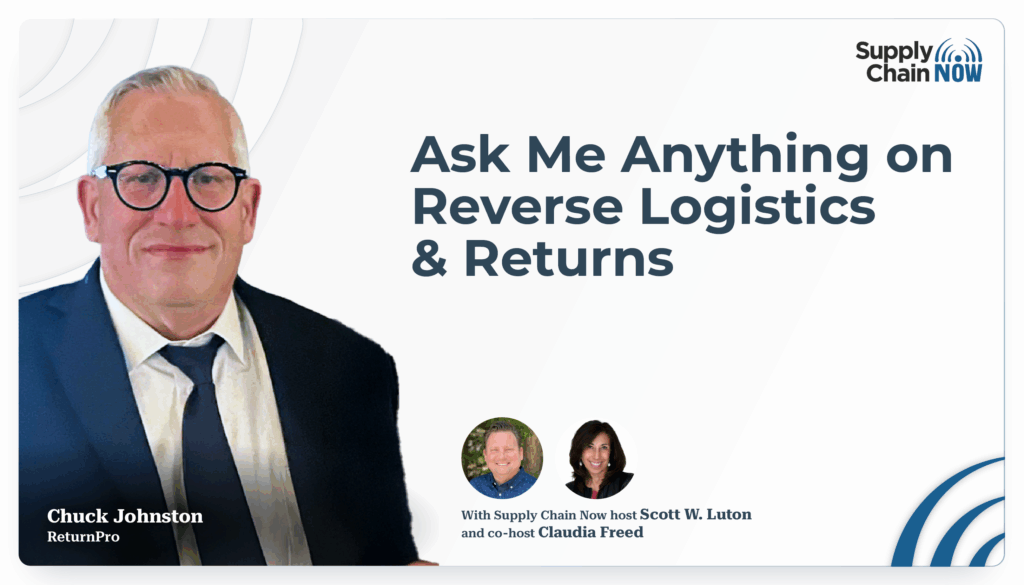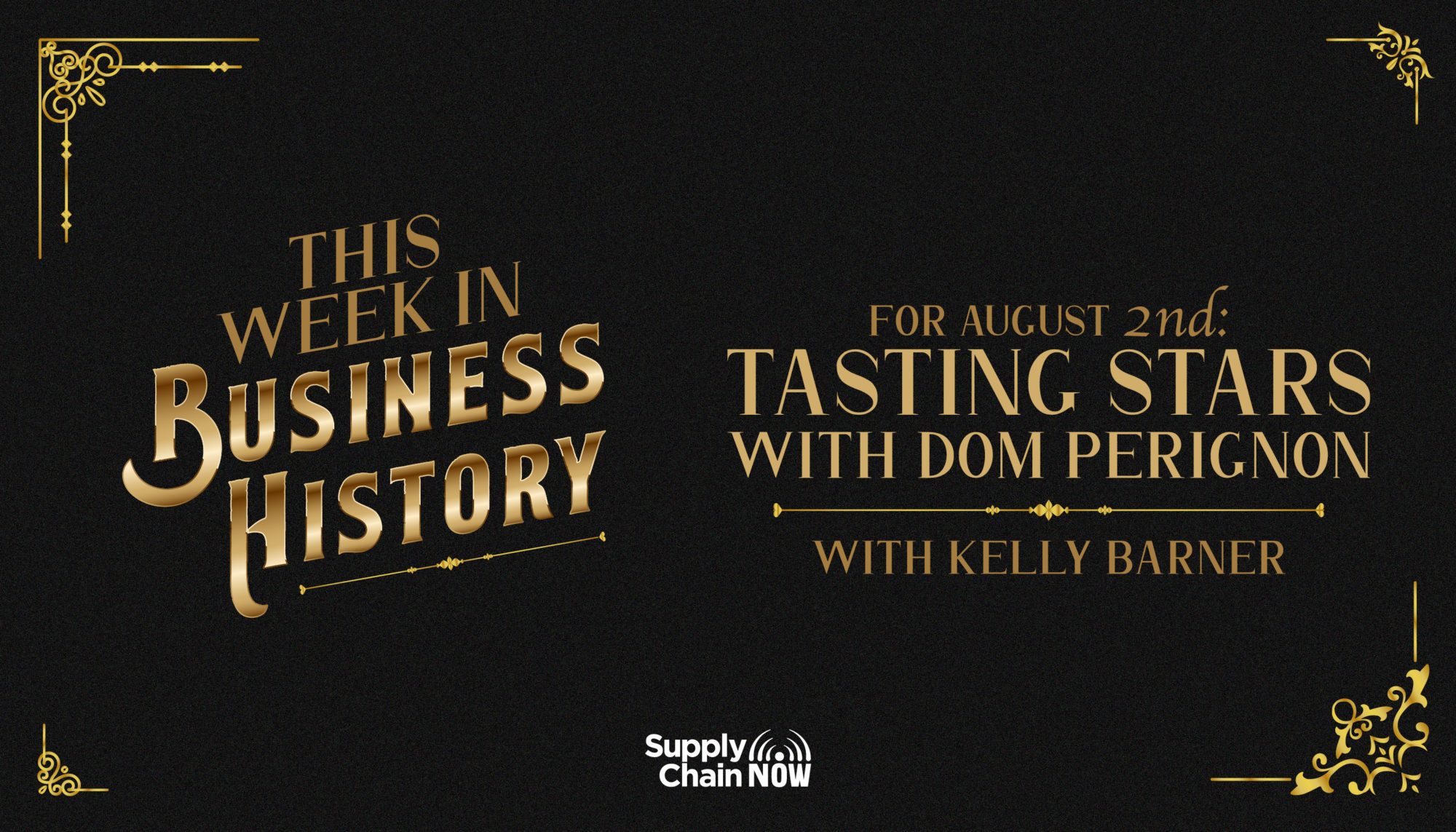Intro/Outro (00:12):
Good morning, Scott Luton here with you on this edition of this week in business history. Welcome to today’s show on this program, which is part of the supply chain. Now family of programming. We take a look back at the upcoming week, and then we share some of the most relevant events and milestones from years past, of course, mostly business focused with a little dab global supply chain. And occasionally we might just throw in a good story outside of our primary realm. So I invite you to join me on this. Look back in history, to identify some of the most significant leaders, companies innovations, and perhaps lessons learned in our collective business journey. Now let’s dive in to this week in business history
Kelly Barner (01:11):
On July 8th, 2022 brothers Giovanni and Pierro bono brought what may be the most expensive bottle of wine ever sold more specifically, the wine was champagne and it is made from premier crew grapes, a blend of Pinot noir Mooner and Chardonnay grown of the champagne region of France. They paid $2.5 million for the bottle, but before you start worrying that inflation has finally ruined everything. This isn’t just a bottle of high class bubbly. The bottle was printed with five NFTs or non fungible tokens. And while in my opinion, they are horribly ugly. They are apparently valuable enough so that the brothers see this as a good investment, but the roots of champagne couldn’t be further from our modern world of NFTs. It goes as far back as August 4th, 1693, when a monk named Dom per became famous for his contributions to the science behind champagne, I’m Kelly Barner. And I’m your host for this episode of this week in business history on supply chain.
Kelly Barner (02:35):
Now I love history and I also happen to love champagne. When we research these episodes business history, milestones get pretty thin before about 1700, the only things written down at all back then were Royal births, deaths, marriages, and important battles. In this week’s episode, we get a unique treat, a business milestone, at least allegedly dating back to the 16 hundreds. Now I consider that a reason to toast. If you enjoy the unique blend of storytelling and business history that Scott Luton and I share on this week in business history, please take a minute to subscribe to the podcast and share a review that will help others find us. And now back to this week’s business history story shared with you the best I can given that I definitely don’t speak French. One other thing before I go on, I’ll ask a little leeway on this week’s topic.
Kelly Barner (03:45):
Given the age of the information, I’m sure there was a lot of parallel innovation going on at the time, and we know it all wasn’t written down. I’ll do my best to share the story, focusing on facts as much as possible and letting you know when I’ve found interesting contradictions, Don per was born pier per in 1638 in France’s champagne region at age 19, he entered the Benedictine order and served at two different Abbs during his lifetime. Apparently one of the jobs available at an AEY was the seller master Perion had found his calling, but why were monks making wine? Believe it or not. They started out by producing the wine required to celebrate mass, but would go on to perfect. The art and science required to master the skill per was incredibly successful in his role. And thanks to him, the Abbey’s vineyard doubled in size during his lifetime, when he passed away, the order honored him by burying him in a section of the Abbey, traditionally reserved for Abbots. What par achieved during his lifetime was enough to create a legacy that lasts to this day. But as I’ve already suggested, there are a few popular myths associated with him. Let’s review a few of his DIDs and probably didn’t sadly, Don per probably did not invent champagne or sparkling wine, but he did experiment and establish quality control measures that completely revolutionized its production. In particular, he worked hard to prevent an uncontrolled secondary fermentation, which was seen as a fault and most likely to break the wine bottles.
Kelly Barner (05:54):
Don Pering was not blind, but he was famous for being able to blind taste test and identify which vineyard an individual grape came from. He did not introduce blending to champagne, but he did start blending the grapes prior to sending them to press most disappointing. To me, he probably did not say the famous quote attributed to him come quickly. I’m tasting stars, that quote and the attribution to doper and young first appeared in a print advertisement for champagne in the late 18 hundreds. He did come up with other innovations, such as limiting the height of the vine to three feet, improving picking techniques to preserve the soil and avoiding skin contact during the pressing process, making it possible to achieve the whiter hue that we associate with champagne today. Don para’s biggest contribution to wine was a production style called metho. CWA secondary fermentation or fermentation is what gives champagne its bubbles.
Kelly Barner (07:17):
They tickle your nose and give champagne cos their pop. But if the process is not managed correctly, those same carbon dioxide bubbles can blow up your glass bottles in a chain reaction that ruins your entire stock of champagne. Secondary fermentation was discovered by mistake as all of the best things are when white wines stored through the winter started to warm up with spring temperatures. This change in conditions brought the yeast back to life. So Perol may not have tasted the stars, but he did manage to harness the power of the bubble in 17, 18, 3 years after Don Paro passed away can and goodie know published a set of champagne making rules credited to per these rules included that fine wine should only be made from Pinot noir because white grapes were more likely to enter that uncontrolled re fermentation that the harvest should be done in cool damp conditions, such as during and early morning, rotten and unusually large grapes were to be thrown out and no foreign substances were to be added during the winemaking process.
Kelly Barner (08:43):
Lastly, the grapes were not to be treaded or smashed underfoot. I love Lucy style. Instead he invented a gentle press called the co car press. This allowed him to use black grapes to make clear white wine. Now, most of us today know Dom par as a brand of champagne. That brand was originally owned by champagne, Mercer, a champagne producer or house as they were called, but they actually never made use of it. Although they did plant the first vintage of grapes that would be used for that brand in 1921, when Francine Daud Meier married Paul Shannon Moe in 1927, it was part of her dowry. Yes, you heard that right? Her dowry in 1927. Now champagne, even the world’s best champagne is not impervious to world events. And that brings us in our story to the great depression. Interestingly, while the depression hit the United States and the United Kingdom in 1929, the great depression did not affect the economy of France until 1931, regardless of timing, the demand for champagne pretty much dried up and all of the best houses responded by slashing their prices and therefore their costs.
Kelly Barner (10:20):
And yet it was not enough to keep them afloat. Nearly all of the houses shut down production and many also sold off their vineyards. The situation was definitely dire, but that is not where our story ends at a meeting of the Champaign growers union in 1932, Lawrence ven, an English journalist and the union’s marketing representative shared an idea. He said, look, we can’t make any money selling this low quality champagne. And we can’t find enough people to sell expensive champagne too. Let’s do this. Let’s only sell a very few bottles of wicked expensive champagne to the richest people in the world. Now keeping in mind that he probably didn’t say wicked, but you get the idea. He also had the foresight to suggest putting the champagne in a replica of an original 18th century glass bottle and to price it at double the price of the most expensive vintage champagne ever sold the growers union members said you are absolutely crazy.
Kelly Barner (11:38):
All of the growers that is except one, Robert John, Dave Vogue, Moe and Chandon took vintage dinner that very night. And the two men continued the discussion within three years, 300 replica, 18th century bottles of champagne were on their way to some of the wealthiest people in the UK. It started making the rounds among elite British circles and quickly found its way to America rather than being a house like champagne Meier, Don per is mot and Chandon’s top covet. That means that every year, the very best grapes go into Dom per wines. And since the 1940s, it has had a dedicated production process that association between champagne and wealth continues to this day. According to allied market research, most consumers of champagne belong to the top 10% of earners, as you would expect. France continues to play an important role in the market. And since sparkling wine can only be called champagne, if it actually comes from champagne, France, they own 100% of that market.
Kelly Barner (13:05):
Even when we brought in the market to include sparkling wine, France still represents half of the world’s production. Champagne is the country’s second largest export industry and mot and the company that owns the dopa and ya brand is the largest champagne producer making over 30 million bottles a year. There are 16,000 wine growers and 320 houses of champagne in the champagne trade association today. So who is drinking all of that bubbly, the United Kingdom consumes more champagne than any other country in the world. They import about 21 million bottles a year. And while the United States is a in second place from a volume standpoint, in some years, the value of their total imports actually surpasses the value of the UK’s imports.
Kelly Barner (14:09):
Now I don’t mean to induce panic, but in 2021, the world saw the smallest gray harvest in 40 years due to extreme weather, there was a 60% drop from the typical harvest concern over future shortages has already led to a spike in demand and Dom per has seen price increases as high as 9% already. According to decanter.com in 2019, the champagne market was worth $5.3 billion. It is projected to reach nearly 6 billion by 2025 and over 11 billion by 2032. A lot of people in a lot of countries owe an awful lot to a monk who lived in France over 300 years ago. So cheers to you Dom Perina you may not have said it, but I do hope you are tasting the stars. Now, before I wrap, I would be remiss if I didn’t connect two of the stories that I shared today, my opening news about the 2.5 million bottle of champagne with the ugly NFTs on it. And the industry saving 18th century replica sold during the depression. It doesn’t matter how good a product is. If the marketing surrounding it is weak, especially something like champagne, where the moment usually calls for a splash of extra money. And the desire to create a bit of magic is just as important as the taste of what’s in the bottle. Interesting that almost 100 years apart, two different groups of people in the champagne industry understood that and used it to boost the price and the value of their product.
Kelly Barner (16:10):
On that note, it is time to wrap up this edition of this week in business history. Thank you so much for tuning into the show each week. Don’t forget to check out the wide variety of industry thought leadership available@supplychainnow.com as a friendly reminder, you can find this week in business history, wherever you get your podcast from and be sure to tell us what you think we would love to earn your review. And we encourage you to subscribe so that you never miss an episode on behalf of the entire team here at this week in business history and supply chain. Now this is Kelly Barner wishing you all, nothing but the best. We’ll see you next time here on this week in business history,



